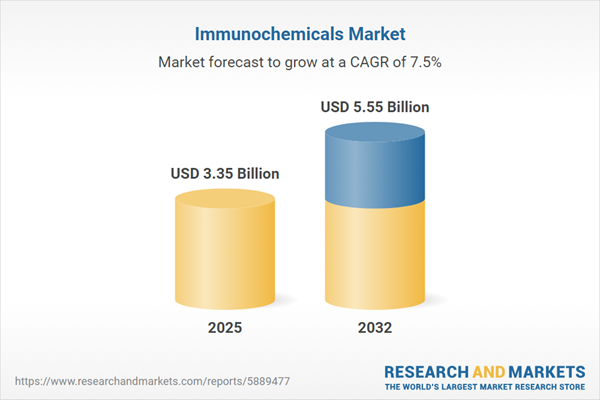Speak directly to the analyst to clarify any post sales queries you may have.
The immunochemicals market is rapidly evolving, responding to transformative scientific advances, policy changes, and shifting end-user priorities. As innovation drives new applications within diagnostics, therapeutics, and research, senior executives face increasingly complex decisions regarding technology adoption, risk management, and global expansion.
Market Snapshot: Immunochemicals Market Size and Outlook
The immunochemicals market grew from USD 3.12 billion in 2024 to USD 3.35 billion in 2025. It is expected to continue expanding at a CAGR of 7.45%, reaching USD 5.55 billion by 2032. This growth is underpinned by investments in scientific innovation, tightening regulatory standards, and rising demand for precise diagnostic and therapeutic tools across geographies. As market dynamics intensify, organizations that can anticipate shifts and quickly align their strategies are best positioned to succeed.
Scope & Segmentation
This report provides a comprehensive outlook across all critical segments of the immunochemicals market, emphasizing actionable insights for decision-makers:
- Product Types: Antibodies (including monoclonal, polyclonal, recombinant formats), antigens (such as haptens, peptide antigens, protein antigens), kits (ELISA, flow cytometry, immunohistochemistry, Western blot), and reagents (blocking agents, buffers and destainers, secondary antibodies, substrates).
- Application Areas: Clinical research, diagnostics, drug discovery, and broader research environments.
- End Users: Academic institutes, contract research organizations, diagnostic laboratories, pharmaceutical and biotech companies.
- Technologies: ELISA, flow cytometry (cell surface and intracellular analysis), immunohistochemistry, Western blot.
- Formats: Liquid and lyophilized presentations.
- Label Types: Enzyme, fluorescent, luminescent, and radioactive tags.
- Geographical Coverage: Americas (covering North and Latin America), Europe, Middle East & Africa (including major European and regional markets), and Asia-Pacific (with coverage of all key and emerging economies).
- Key Companies Profiled: Thermo Fisher Scientific Inc., Danaher Corporation, Merck KGaA, Agilent Technologies, Inc., Bio-Rad Laboratories, Inc., PerkinElmer, Inc., Becton, Dickinson and Company, Abcam plc, Bio-Techne Corporation, Promega Corporation.
Key Takeaways for Immunochemicals Stakeholders
- Technological advancements—such as recombinant antibody engineering and improved antigen synthesis—are elevating assay performance, enabling applications previously limited by sensitivity and specificity.
- Growth in the adoption of automated, high-throughput platforms is accelerating operational efficiency for both research and clinical segments, prompting end-users to seek partners with robust digital and manufacturing capabilities.
- Heightened regulatory scrutiny is standardizing product validation and quality control. Compliant suppliers are increasingly viewed as trusted partners by top-tier organizations.
- Diverse regional needs drive differentiated strategies: mature markets emphasize advanced tools and precision, while emerging regions prioritize affordability and flexible supply solutions.
- Strategic collaborations—including joint ventures, cross-industry alliances, and AI-driven platform deployments—are shaping competitive positioning and speeding the commercialization of next-generation products.
Tariff Impact: Navigating U.S. Policy Changes
New U.S. tariffs imposed in 2025 are exerting significant pressure on global supply chains and pricing models for immunochemicals. Organizations are revisiting sourcing strategies, pursuing additional suppliers, and leveraging local manufacturing partnerships to reduce cost volatility. While some entities are fast-tracking format changes (such as lyophilized products) to contain logistics costs, these operational pivots often necessitate complex renegotiations along the value chain. Vertically integrated firms with advanced in-house manufacturing are better positioned to maintain pricing stability and secure supply continuity in the face of evolving trade landscapes.
Immunochemicals Market: Methodology & Data Sources
This analysis integrates primary research, including expert interviews with R&D leaders and procurement stakeholders, alongside secondary research from peer-reviewed journals, patent databases, and regulatory publications. Data triangulation and iterative expert panel review were employed to ensure the reliability, accuracy, and strategic relevance of insights presented.
Why This Report Matters for Senior Decision-Makers
- Equips leaders with a precise understanding of product, application, and regional trends to sharpen strategy and invest proactively.
- Helps optimize supply chain and procurement decisions by clarifying tariff effects and regulatory developments.
- Enables informed partnering and investment by profiling leading competitors and technology trends across the immunochemicals landscape.
Conclusion
The immunochemicals market demands adaptive strategies rooted in robust technology, resilient operations, and deep customer alignment. Organizations that translate insight into action will thrive within this complex, fast-moving sector.
Additional Product Information:
- Purchase of this report includes 1 year online access with quarterly updates.
- This report can be updated on request. Please contact our Customer Experience team using the Ask a Question widget on our website.
Table of Contents
3. Executive Summary
4. Market Overview
7. Cumulative Impact of Artificial Intelligence 2025
Companies Mentioned
The companies profiled in this Immunochemicals market report include:- Thermo Fisher Scientific Inc.
- Danaher Corporation
- Merck KGaA
- Agilent Technologies, Inc.
- Bio-Rad Laboratories, Inc.
- PerkinElmer, Inc.
- Becton, Dickinson and Company
- Abcam plc
- Bio-Techne Corporation
- Promega Corporation
Table Information
| Report Attribute | Details |
|---|---|
| No. of Pages | 197 |
| Published | October 2025 |
| Forecast Period | 2025 - 2032 |
| Estimated Market Value ( USD | $ 3.35 Billion |
| Forecasted Market Value ( USD | $ 5.55 Billion |
| Compound Annual Growth Rate | 7.4% |
| Regions Covered | Global |
| No. of Companies Mentioned | 11 |









